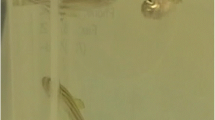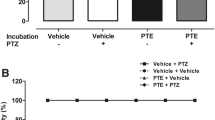Abstract
This study examined the capacity of a known pro-epileptic drug, pentylenetetrazol (PTZ), to elicit seizure-like activity in the medicinal leech, Hirudo verbana. During in vivo experiments, PTZ elicited increased motor activity in a concentration-dependent manner with the highest concentration (10 mM) eliciting episodes of highly uncoordinated exploratory and swimming behavior. Co-application of the anti-epileptic drug, phenytoin, failed to reduce the absolute amount of PTZ-induced motor behavior, but was able to prevent expression of abnormal exploratory and swimming behaviors. During in vitro experiments in which extracellular recordings of connective nerve activity were made, bath application of 1 μM PTZ in Mg2+-free saline elicited a significant increase in spontaneous activity. This PTZ-induced increase in activity was completely inhibited by phenytoin. Interestingly, PTZ-induced hyperactivity was also blocked by co-application of the endocannabinoid 2-arachidonoyl glycerol and the selective serotonin re-uptake inhibitor (SSRI) fluoxetine. These findings suggest that the leech can be a useful system in which to study potential anti-epileptic treatments.



Similar content being viewed by others
References
Baca SM, Marin-Burgin A, Wagenaar DA, Kristan WB Jr (2008) Widespread inhibition proportional to excitation controls the gain of a leech behavioral circuit. Neuron 57:276–289
Baraban SC (2007) Emerging epilepsy models: insights from mice, flies, worms and fish. Curr Opin Neurol 20:164–168
Bhaskaran MD, Smith BN (2010) Cannabinoid-mediated inhibition of recurrent excitatory circuitry in the dentate gyrus in a mouse model of temporal lobe epilepsy. PLoS One 5:e10683
Brown TE, Chirila AM, Schrank BR, Kauer JA (2013) Loss of interneuron LTD and attenuated pyramidal cell LTP in Trpv1 and Trpv3 KO mice. Hippocampus 23:662–671
Burton A (2000) Anti-epileptic drugs for pain management. The internet journal of pain, symptom control and palliative care 1(2)
Calvino MA, Iscla IR, Szczupak L (2005) Selective serotonin reuptake inhibitors induce spontaneous interneuronal activity in the leech nervous system. J Neurophysiol 93:2644–2655
Chavez AE, Chiu CQ, Castillo PE (2010) TRPV1 activation by endogenous anandamide triggers postsynaptic long-term depression in dentate gyrus. Nat Neurosci 13:1511–1518
Cline HT (1983) 3H-GABA uptake selectively labels identifiable neurons in the leech central nervous system. J Comp Neurol 215:351–358
Cline HT (1986) Evidence for GABA as a neurotransmitter in the leech. J Neurosci 6:2848–2856
Cymbalyuk GS, Gaudry Q, Masino MA, Calabrese RL (2002) Bursting in leech heart interneurons: cell-autonomous and network-based mechanisms. J Neurosci 22:10580–10592
De Petrocellis L, Melck D, Bisogno T, Milone A, Di MV (1999) Finding of the endocannabinoid signalling system in Hydra, a very primitive organism: possible role in the feeding response. Neuroscience 92:377–387
Di Marzo V, De Petrocellis L (2012) Why do cannabinoid receptors have more than one endogenous ligand? Philos Trans R Soc B Biol Sci 367:3216–3228
Elphick MR (2012) The evolution and comparative neurobiology of endocannabinoid signalling. Philos Trans R Soc Lond B Biol Sci 367:3201–3215
Gaudry Q, Kristan WB Jr (2009) Behavioral choice by presynaptic inhibition of tactile sensory terminals. Nat Neurosci 12:1450–1457
Giachello CN, Premoselli F, Montarolo PG, Ghirardi M (2013) Pentylenetetrazol-induced epileptiform activity affects basal synaptic transmission and short-term plasticity in monosynaptic connections. PLoS One 8:e56968
Gibson HE, Edwards JG, Page RS, Van Hook MJ, Kauer JA (2008) TRPV1 channels mediate long-term depression at synapses on hippocampal interneurons. Neuron 57:746–759
Grey KB, Burrell BD (2010) Co-induction of LTP and LTD and its regulation by protein kinases and phosphatases. J Neurophysiol 103:2737–2746
Grice SJ, Sleigh JN, Liu JL, Sattelle DB (2011) Invertebrate models of spinal muscular atrophy: insights into mechanisms and potential therapeutics. Bioessays 33:956–965
Grueter BA, Brasnjo G, Malenka RC (2010) Postsynaptic TRPV1 triggers cell type-specific long-term depression in the nucleus accumbens. Nat Neurosci 13:1519–U1107
Hiroi R, Lacagnina AF, Hinds LR, Carbone DG, Uht RM, Handa RJ (2013) The androgen metabolite, 5α-androstane-3β, 17β-diol (3β-diol), activates the oxytocin promoter through an estrogen receptor-beta pathway. Endocrinology 154:1802–1812
Igelstrom KM, Heyward PM (2012) The antidepressant drug fluoxetine inhibits persistent sodium currents and seizure-like events. Epilepsy Res 101:174–181
Im SH, Galko MJ (2012) Pokes, sunburn, and hot sauce: drosophila as an emerging model for the biology of nociception. Dev Dyn 241:16–26
Iskedjian M, Bereza B, Gordon A, Piwko C, Einarson TR (2007) Meta-analysis of cannabis based treatments for neuropathic and multiple sclerosis-related pain. Curr Med Res Opin 23:17–24
Izzo AA, Borrelli F, Capasso R, Di Marzo V, Mechoulam R (2009) Non-psychotropic plant cannabinoids: new therapeutic opportunities from an ancient herb. Trends Pharmacol Sci 30:515–527
Jobe PC, Browning RA (2005) The serotonergic and noradrenergic effects of antidepressant drugs are anticonvulsant, not proconvulsant. Epilepsy Behav 7:602–619
Katona I, Freund TF (2008) Endocannabinoid signaling as a synaptic circuit breaker in neurological disease. Nat Med 14:923–930
Katona I, Freund TF (2012) Multiple functions of endocannabinoid signaling in the brain. Annu Rev Neurosci 35:529–558
Kristan WB Jr, Calabrese RL, Friesen WO (2005) Neuronal control of leech behavior. Prog Neurobiol 76:279–327
Lehtonen M, Reisner K, Auriola S, Wong G, Callaway JC (2008) Mass-spectrometric identification of anandamide and 2-arachidonoylglycerol in nematodes. Chem Biodivers 5:2431–2441
Li Q, Burrell BD (2009) Two forms of long-term depression in a polysynaptic pathway in the leech CNS: one NMDA receptor-dependent and the other cannabinoid-dependent. J Comp Physiol A Neuroethol Sens Neural Behav Physiol 195:831–841
Li Q, Burrell BD (2010) Properties of cannabinoid-dependent long-term depression in the leech. J Comp Physiol A Neuroethol Sens Neural Behav Physiol 196:841–851
Li Q, Burrell BD (2011) Associative, bidirectional changes in neural signaling utilizing NMDA receptor- and endocannabinoid-dependent mechanisms. Learn Mem (Cold Spring Harbor, NY) 18:545–553
Li J, Le W (2013) Modeling neurodegenerative diseases in Caenorhabditis elegans. Exp Neurol 250:94–103
Mainardi P, Leonardi A, Albano C (2008) Potentiation of brain serotonin activity may inhibit seizures, especially in drug-resistant epilepsy. Med Hypotheses 70:876–879
Marsicano G, Goodenough S, Monory K, Hermann H, Eder M, Cannich A, Azad SC, Cascio MG, Gutiérrez SO, van der Stelt M, López-Rodríguez ML, Casanova E, Schütz G, Zieglgänsberger W, Di Marzo V, Behl C, Lutz B (2003) CB1 cannabinoid receptors and on-demand defense against excitotoxicity. Science 302:84–88
Matias I, Bisogno T, Melck D, Vandenbulcke F, Verger-Bocquet M, De Petrocellis L, Sergheraert C, Breton C, Di MV, Salzet M (2001) Evidence for an endocannabinoid system in the central nervous system of the leech Hirudo medicinalis. Brain Res Mol Brain Res 87:145–159
Mazzoni A, Broccard FD, Garcia-Perez E, Bonifazi P, Ruaro ME, Torre V (2007) On the dynamics of the spontaneous activity in neuronal networks. PLoS One 2:e439
McClung C, Hirsh J (1999) The trace amine tyramine is essential for sensitization to cocaine in Drosophila. Curr Biol 9:853–860
Muller KJ, Nicholls JG, Stent GS (1981) Neurobiology of the leech. Cold Spring Harbor Laboratory Press, Cold Spring Harbor
Nestler EJ, Hyman SE, Malenka RC (2001) Molecular Neuropharmacology. McGraw-Hill Companies, Inc., New York
Parker L, Howlett IC, Rusan ZM, Tanouye MA (2011) Seizure and epilepsy: studies of seizure disorders in Drosophila. Int Rev Neurobiol 99:1–21
Regesta G, Tanganelli P (1999) Clinical aspects and biological bases of drug-resistant epilepsies. Epilepsy Res 34:109–122
Scholz H, Mustard JA (2013) Invertebrate models of alcoholism. Curr Top Behav Neurosci 13:433–457
Sombati S, Delorenzo RJ (1995) Recurrent spontaneous seizure activity in hippocampal neuronal networks in culture. J Neurophysiol 73(4):1706–1711
Sovik E, Barron AB (2013) Invertebrate models in addiction research. Brain Behav Evol 82:153–165
Therisa KK, Desai PV (2011) Study of epileptiform activity in cerebral ganglion of mud crab Scylla serrata. Invertebr Neurosci 11:21–27
Walters ET, Moroz LL (2009) Molluscan memory of injury: evolutionary insights into chronic pain and neurological disorders. Brain Behav Evol 74:206–218
Yuan S, Burrell BD (2010) Endocannabinoid-dependent LTD in a nociceptive synapse requires activation of a presynaptic TRPV-like receptor. J Neurophysiol 104:2766–2777
Yuan S, Burrell BD (2012) Long-term depression of nociceptive synapses by non-nociceptive afferent activity: role of endocannabinoids, Ca2+, and calcineurin. Brain Res 1460:1–11
Zurolo E, Iyer AM, Spliet WG, Van Rijen PC, Troost D, Gorter JA, Aronica E (2010) CB1 and CB2 cannabinoid receptor expression during development and in epileptogenic developmental pathologies. Neuroscience 170:28–41
Zygmunt PM, Petersson J, Andersson DA, Chuang H, Sorgard M, Di Marzo V, Julius D, Hogestatt ED (1999) Vanilloid receptors on sensory nerves mediate the vasodilator action of anandamide. Nature 400:452–457
Acknowledgments
Supported by Grants from the National Science Foundation (IOS-0432683, B. Burrell), the University of South Dakota UDiscover Undergraduate Research Program (E. Hahn), and by a subproject of the National Institutes of Health Grant (P20 RR015567, J. Keifer), which is designated as a Center of Biomedical Research Excellence (COBRE).
Conflict of interest
None.
Author information
Authors and Affiliations
Corresponding author
Electronic supplementary material
Below is the link to the electronic supplementary material.
Supplementary material 1 (AVI 7644 kb)
Supplementary material 2 (AVI 17378 kb)
Rights and permissions
About this article
Cite this article
Hahn, E., Burrell, B. Pentylenetetrazol-induced seizure-like behavior and neural hyperactivity in the medicinal leech. Invert Neurosci 15, 1 (2015). https://doi.org/10.1007/s10158-014-0177-1
Received:
Accepted:
Published:
DOI: https://doi.org/10.1007/s10158-014-0177-1




